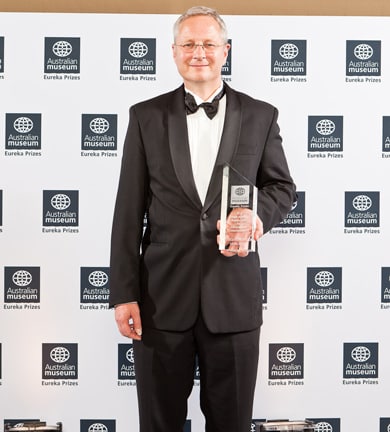Mode-Locked Laser Using a Micro-Cavity Resonator
An international team of scientists, including Dr David Moss, from the University of Sydney's School of Physics, has created a new form of ultra small laser that will revolutionise many fields.The innovation, published and featured on the front cover of the prestigious journal Nature Communications on 3 April 2012, is the first laser to be mode-locked using a micro-cavity resonator. This makes the laser highly precise, ultra fast and ultra small. |
Dr David Moss, from the University of Sydney's School of Physics, with an international team of scientists, has created a new form of ultra small laser that will revolutionise many fields. (Here Dr Moss is seen winning the 2011 Australian Museum Eureka Prize for Innovation in Computer Science.)
|
The team that Dr Moss worked with included scientists from Institut National de la Recherche Scientifique (INRS) in Canada, the Istituto per i Processi Chimico-Fisici part of the Consiglio Nazionale delle Ricerche in Italy and Infinera Ltd in the United States.
"Our new laser opens up a whole field of possibilities in terms of high precision, ultra small, integrated lasers," said Dr Moss, who is based in CUDOS - the ARC Centre of Excellence for Ultrahigh Bandwidth Devices for Optical Systems - and the Institute of Photonics and Optical Science at the University of Sydney.
"It's the first time we've been able to use a micro-cavity resonator to lock the modes of a laser, which is how ultra-short pulsed lasers are created. Lasers that have their modes locked generate the shortest optical pulses of light," explained Dr Moss.
"The micro-cavity is a glass based integrated ring resonator where the laser light modes are generated and locked extremely efficiently, because we've engineered the resonator to have ideal qualities, particularly nonlinear optical properties."
Making lasers that can pulse at very high and flexible repetition rates - much higher than those achieved with electronics - is a field that has been pursued by scientists around the world. Different research groups have proposed a variety of solutions to creating these lasers, but have not been successful in creating a stable laser of this sort, until Dr Moss' team's success.
"Our new laser achieves extremely stable operation at unprecedentedly high repetition rates of 200 Gigahertz, while maintaining very narrow linewidths, which leads to an extremely high quality pulsed emission," said Dr Moss.
The new laser will have applications in computing, measuring and diagnosing diseases, and processing materials - all areas where lasers are already used. It will also open up entirely new areas such as precision optical clocks for applications in metrology, ultra-high speed telecommunications, microchip-computing and many other areas.
 |
Dr David Moss and team's new laser is featured on the front cover of the prestigious journal Nature Communications.
|
Dr Moss' work on the new laser continues his success in computing innovation, for which he won the 2011 Australian Museum Eureka Prize for Innovation in Computer Science.
"In order to make our laser work, we use a new mode-locking method we've called Filter-Driven Four-Wave-Mixing. What's really different about this, is that the resonator is not simply used as a filter, but acts as the nonlinear element as well," explained Dr Moss.
"Traditional Four-Wave-Mixing schemes make the nonlinear interaction occur in the fibre, then filter the light separately using a linear Fabry Pérot filter," said Dr Moss.
"However, in our new system we have the resonator playing these two roles, making our laser intrinsically more efficient and with a radically shorter cavity length."
The reduced cavity length substantially increases the main cavity mode frequency spacing, making a dramatically more stable laser.
"This new laser is a versatile, stable, efficient and ultra small laser, which offers many exciting applications in a huge range of areas."
SOURCE: http://sydney.edu.au/news/science/397.html?newsstoryid=8973
Author: Katynna Gill
No comments:
Post a Comment